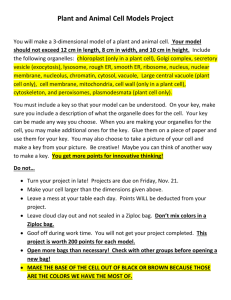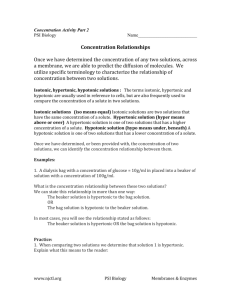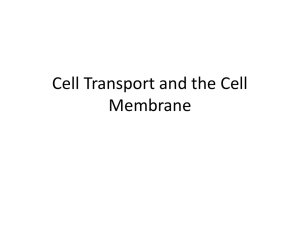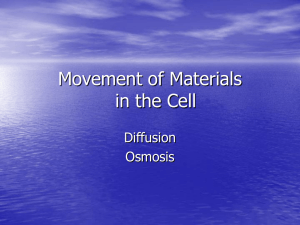LAB 4: Cellular Transport
advertisement
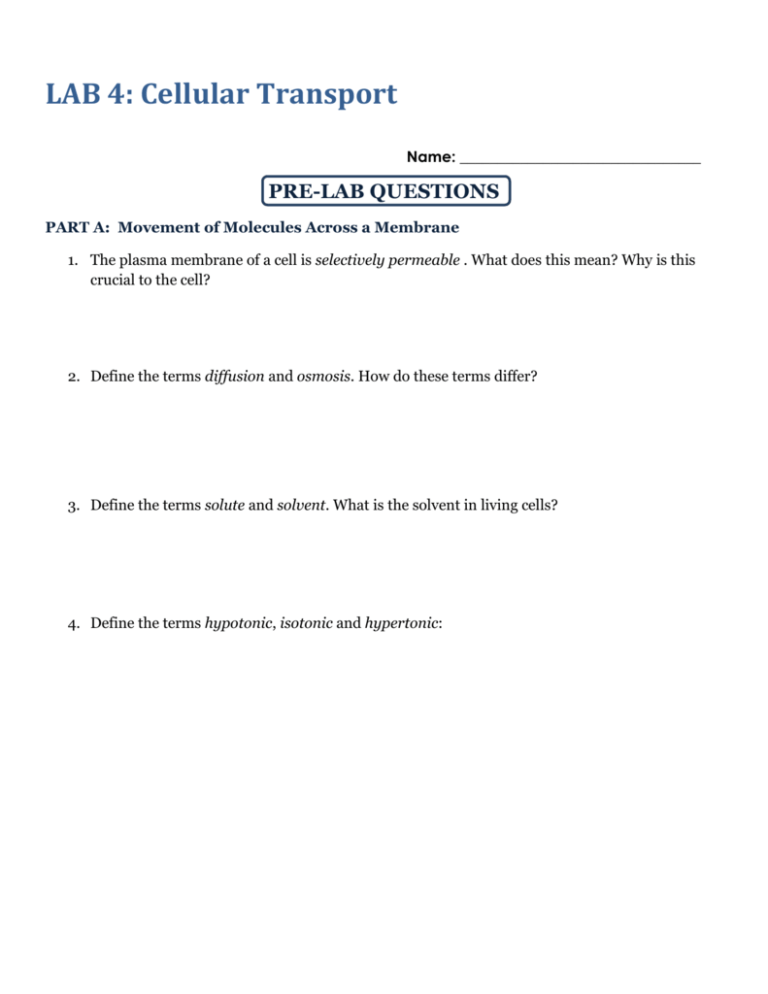
LAB 4: Cellular Transport Name: ________________________________ PRE-LAB QUESTIONS PART A: Movement of Molecules Across a Membrane 1. The plasma membrane of a cell is selectively permeable . What does this mean? Why is this crucial to the cell? 2. Define the terms diffusion and osmosis. How do these terms differ? 3. Define the terms solute and solvent. What is the solvent in living cells? 4. Define the terms hypotonic, isotonic and hypertonic: LAB 4: Cellular Transport Purpose: To observe passive transport of various substances across a selectively permeable membrane. PART A – Movement of Molecules Across a Membrane Introduction – In order for cells to maintain homeostasis, there is a continuous exchange of materials into and out of the cell. Cells are surrounded by a selectively permeable plasma membrane, which allows some substances to pass through, but not others. Molecules can move across the plasma membrane either by passive transport, which requires no energy input from the cell, or by active transport, which does require energy input, usually in the form of ATP. During passive transport, molecules move from an area of high concentration (where they are many) to an area of low concentration. This process is called diffusion. The molecules eventually become evenly distributed throughout the solution, at which point they have reached equilibrium. Molecules that are dissolved in a solution are called solutes. The liquid in which they are dissolved is the solvent. Osmosis is the diffusion of water from an area of high water concentration to an area of low water concentration through a selectively permeable membrane. A difference in the concentration of water occurs when there is a higher concentration of solute on one side of a membrane than on the other, and the membrane is not permeable to the solute. Since water can pass freely across the plasma membrane, it will move across the membrane by osmosis until the solute concentration (and the water concentration) is the same on both sides of the membrane, at which point equilibrium has been reached. Figure 4.1. Osmosis: the movement of water across a selectively permeable membrane from an area of high concentration to an area of low concentration. From http://www.goldiesroom.org/ LAB 4: Cellular Transport The terms hypertonic, isotonic and hypotonic refer to the relative concentrations of two solutions separated by a selectively permeable membrane. A hypertonic solution refers to a greater concentration. In biology, a hypertonic solution is one with a higher concentration of solutes on the outside of the cell. When a cell is immersed into a hypertonic solution, the tendency is for water to flow out of the cell in order to balance the concentration of the solutes.An isotonic solution has a solute concentration equal to that of the solution on the other side of the membrane. The concentration of both water and total solute molecules are the same in an external solution as in the cell content. Water molecules diffuse through the plasma membrane in both directions, and as the rate of water diffusion is the same in each direction that cell will neither gain nor lose water.Since the two solutions are at equilibrium, there is no net movement of water across the membrane. A hypotonic solution refers to a lesser concentration. A hypotonic solution has a lower concentration of solute in its surroundings, so in an attempt to balance concentrations, water will rush into the cell, causing swelling. HYPERTONIC ISOTONIC HYPOTONIC PART B – Osmosis in Plant Cells Introduction – When an animal cell is in an isotonic solution, the cell’s volume remains constant since it is at equilibrium with the solution - water is moving into and out of the cell at equal rates. If an animal cell is in a hypotonic solution (lower solute concentration in the solution than in the cell), water will enter the cell from the solution, causing it to swell and eventually to burst. In a hypertonic solution (higher solute concentration in the solution than in the cell), water will move out of the cell and into the solution, causing the cell to shrivel (see illustration below). LAB 4: Cellular Transport In a plant cell the situation is somewhat different. Plant cells are surrounded by a cell wall, which provides protection and structural support to the cell. The cell wall is fairly rigid, and prevents the cell from taking up enough water to burst when in a hypotonic solution. Instead a plant cell in a hypotonic environment expands up to the point at which the cell wall exerts enough back pressure, or turgor pressure, to prevent more water from entering. A plant cell under these conditions is turgid (very firm), which is its normal, healthy state and is necessary in order for the plant to maintain its upright posture. If a plant is in an isotonic environment, where there is no net movement of water into the cells, and therefore no turgor pressure, the cells and the plant itself become flaccid (limp). Finally, in a hypertonic environment, water exits the plant cell, causing the plasma membrane to shrivel, and eventually to pull away from the cell wall, a condition called plasmolysis, which can lead to the death of the cell. Osmosis in Plant Cells: Osmosis in Red Blood Cells: LAB 4: Cellular Transport Part A: Movement of Molecules Across a Membrane Overview- Students will model diffusion and osmosis by using chemical indicators to test for the movement of molecules across a selectively permeable membrane. Students will use iodine solution and Benedict’s solution after dialysis is complete to test for the presence of starch and glucose respectively, in the dialysis tubing and in the beaker water. When iodine solution is added to a solution, if starch is present the solution will change from its original yellow color to purple or black. When Benedict’s Solution is added to a solution, if glucose is present and the solution is heated, the solution will change from its original blue color to green, orange or brown, depending on the glucose concentration. Part A Materials for the lab group of 4 students : Dialysis roll Benedict’s Solution Scissors Iodine Solution 2 long pieces of thread 6 Test tubes 1% Starch solution Wax pencil 30% Glucose solution Test tube rack 3 Beakers 5 disposable pipettes Distilled Water Hot Plate Boiling chips – at front of room test tube tongs Part A - Procedure – Preparation of the Dialysis Bag: 1. Using scissors cut off an 8 inch length of dialysis tubing from the roll. 2. Soak the dialysis tubing in warm water for about 5 minutes to allow the membranes to open. 3. Tie off one end using a piece of string to form a leak proof bag. The knot should be about an inch from the end of the tubing. 4. Add 4 ml of starch solution to the bag. 5. Add 4 ml of glucose solution to the bag. 6. Tie off open end of the bag using a piece of string and check for leaks. 7. Holding the bag over the sink, rinse off bag with distilled water to remove any starch or sugar. LAB 4: Cellular Transport Preparation of Beaker: 8. Place 200 mL of DI water into a 400 mL beaker 9. Place dialysis bag in the beaker 10. Wait 20 minutes. Testing for presence of starch and glucose: 11. Fill a new beaker ½ full with tap water and place on the hot plate. Add a few boiling chips to the beaker. Bring the water to a boil. 12. While you are waiting for the water to boil, label six test tubes: bag 1, bag 2, beaker 1, beaker 2, water 1, water 2, and place them in the test tube rack. 13. Remove the dialysis bag from the beaker and place it in a dry beaker. Use scissors to carefully cut the top off the bag. 14. Using a disposable pipette, add 2 pipettesful of the bag solution to each of the test tubes labeled “bag 1” and “bag 2”. 15. Using a disposable pipette, add 2 pipettesful of the beaker solution to each of the test tubes labeled “beaker 1” and “beaker 2”. 16. Using a disposable pipette, add 2 pipettesful of water to each of the test tubes labeled “water 1” and “water 2”. 17. Add 2 drops of iodine solution to the test tubes labeled “bag 1”, “beaker 1” and “water 1”. A color change from amber to purple will be evident immediately if starch is present. Be careful, iodine stains. 18. Put on your safety glasses. Add 3 drops of Benedict’s solution to the test tubes labeled “bag 2”, “beaker 2” and “water 2”. Benedict’s solution, unlike iodine solution, is an indicator that requires heat to change color. Place the test tubes in the beaker of boiling water for 10 minutes. Turn off the hot plate and examine the contents of each test tube. A color change from light blue to green, orange or brown indicates that glucose is present. LAB 4: Cellular Transport Part B –Osmosis in Plant Cells Overview- Students will examine osmosis in plants cells by observing Elodea leaves placed in distilled water or in a 20% salt solution under the microscope. Part B – Materials for the lab group of 2 students: Elodea 20% Salt Solution Forceps Droppers 2 Slides Distilled water 2 Cover Slips Compound Microscope Part B - Procedure –Osmosis in Plant Cells 1. 2. 3. 4. Pull 2 small leaves from the growing tip of an Elodea shoot with a pair of forceps. Prepare a wet mount of the first leaf using distilled water. Observe under the microscope. Prepare a wet mount of the second leaf using 20% NaCl. Observe under the microscope. Wait 15 minutes, then observe the cells in each leaf with the compound microscope. Compare your initial observations to what you see after 15 minutes. Compare the cells in distilled water to those in 20% NaCl. In the data collection section below, draw a picture of a cell in distilled water and a cell in 20% NaCl. Make your drawings large and clear. LAB 4: Cellular Transport Data Collection – Name: ____________________ PART A: The two tubes to which you added water (“water 1” and “water 2”) serve as negative controls – since water does not contain starch or glucose, neither the iodine nor Benedict’s reagent should react with water. These tubes show the color that results with each of the chemical indicators in the absence of a reaction. By comparing the appropriate negative control to your other tubes, you can determine whether or not a reaction occurred in each of tubes “bag 1”, “bag 2”, “beaker 1” and “beaker 2”. 1. Complete the results table below. Source of solution being tested Color after iodine test (tube 1) Is starch present? + or - Color after Benedict’s test (tube 2) Dialysis bag Beaker Water (negative control) PART B: Sketches: Distilled Water After 15 Minutes Observations: Magnification:______X Is glucose present? + or - LAB 4: Cellular Transport 20%NaCl Water After 15 Minutes Observations: Magnification:______X LAB 4: Cellular Transport Name: _________________________ Date: ________________________ POST-LAB QUESTIONS Part A: Dialysis Lab 1. Relate the behavior of the dialysis membrane to the behavior of a cell membrane. Use information from the lab to explain your answer. 2. Describe the movement of molecules across the membrane based on your results. Be sure to mention which molecules moved in/ out of the bag. Explain how you arrived at your answer. 3. Explain the role of concentration gradients in the movement of molecules that you observed in this experiment. 4. Which type of transport is being illustrated? Is it active or passive? Explain your answer. 5. Predict what would happen if you did an experiment in which the iodine solution was placed in the dialysis bag and the starch solution was in the beaker. Be detailed in your description. LAB 4: Cellular Transport 6. A patient with partial kidney failure enters the hospital. The doctor tells the patient that the kidney is responsible for filtering and removing waste molecules from body fluids. The doctor recommends use of a kidney dialysis machine. Using your knowledge of diffusion, osmosis, and dialysis, what do you think the dialysis machine will do for this patient? 7. You are admitted to the hospital with severe dehydration. A student nurse is directed to give you a transfusion of blood plasma to replace your lost body fluids. The nurse gives you a transfusion of distilled water by mistake. Explain what will happen to your red blood cells. In your explanation, use the following words: cell membrane, osmosis, high concentration, and low concentration. Part B: Osmosis in Elodea 8. What happened to the Elodea cells bathed in distilled water? Explain your answer using the terms hypotonic and hypertonic. 9. What happened to the Elodea cells bathed in 20% NaCl? Explain your answer using the terms hypotonic and hypertonic. LAB 4: Cellular Transport 10. Plants wilt when deprived of water. What happens at the cellular level to cause the wilting?
